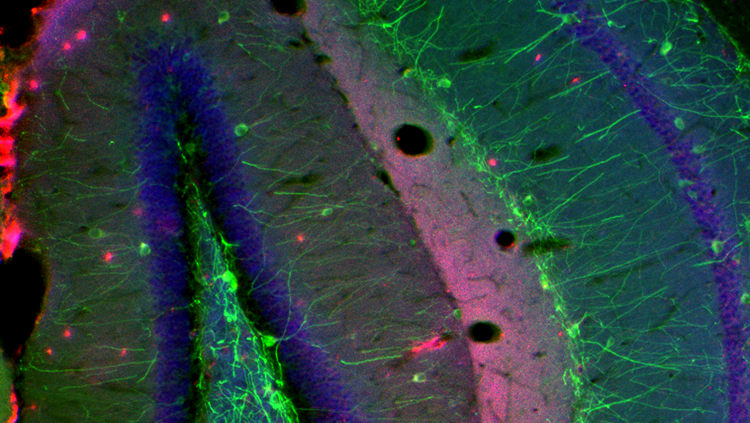In Science, Slow and Steady Wins the Race
- Published18 Jun 2013
- Author Emily Rose Jordan
- Source BrainFacts/SfN
Multiple sclerosis (MS) is a devastating neurological disease where the protective layer around nerves begins to die off, attacked by the body's own immune system. Without this insulation, the nervous system begins to shut down. Eventually, many people with MS lose the ability to move, speak and control basic bodily functions. Patients usually get their diagnosis in the prime of life and there is nothing to be done besides taking drugs that will postpone the progression of symptoms. These treatments are associated with side effects that can be as debilitating as the disease itself and they are hugely expensive.
So, in 2006 when an Italian physician, Dr Paolo Zamboni, announced a simple method for treating MS, it received international attention. Zamboni theorised that MS was caused by a lack of blood flow in the brain and that by restoring proper blood flow the disease would dissipate. This was a completely novel idea; most scientists working on MS were investigating the immune system, not the venous system.
Zamboni measured blood flow in MS patients using a Doppler scan technique and showed that MS was associated with extracranial stenosis, the narrowing of blood vessels in the neck. He called this condition chronic cerebrospinal venous insufficiency (CCSVI) and showed that by surgically enlarging the veins, patients got better.
After this initial research was published, patients clambered to access the treatment - a surgery that could solve their suffering where no amount of expensive pharmaceuticals could help.
Because of the severity of MS and lack of treatments, MS patients are highly active in disease associations and involved in fundraising efforts for research. Patients voiced their desire to access CCSVI surgery and, despite only preliminary evidence of its efficacy from Zamboni's studies, money started being funneled into studying the procedure. The MS Society of Canada, for example, allocated $2.4 million for CCSVI research in 2010, and other trials of the procedure were launched around the world.
However, many patients requested the treatment and paid for the surgery out of their own pockets before any large scale, controlled trials had been completed. CCSVI had received a lot of media attention and patients were eager to benefit from the treatment before it was fully understood.
Opening up veins in the neck is no small task and surgeons were using stents and tools that were not yet approved for use in the neck. Some people suffered severe adverse events resulting from the surgeries, such as strokes. Other patients died. However, patients were so keen for a cure that, despite relapsing after the surgery, some underwent the same procedure again, in the hope that it would help them.
Then, other labs started publishing results of their research on CCSVI. Most of these studies contradicted Zamboni's results. There was no difference in the blood flow of MS patients and healthy controls and there was no benefit to the surgery. Doppler measurements of extracranial blood flow were temperamental and unreliable.
It seemed like Zamboni's CCSVI was a fluke result due to bad experimental techniques or a small sample size.
Zamboni continued to advocate his theory and replicate his results in small studies, but if only one doctor out of many can achieve an effective outcome using a medical treatment, warning bells start to go off. Large scale, randomised, controlled clinical trials on CCSVI have not yet been completed, but results from these studies will be able to definitively confirm or refute the involvement of CCSVI in MS. It is astonishing in the meantime that one man's theory and a few small experiments have resulted in millions of dollars of research funds spent, thousands of scientist hours being wasted and patient health and finances being risked prematurely.
Medical associations have begun to discount CCSVI now that more evidence has emerged, but the story of CCSVI serves as an important example of the need for rigorous, randomised, controlled clinical trials of medical treatments before they are unleashed on a desperate patient population.
Patients suffering from chronic diseases and their families are anxious to try anything to get better. CCSVI was the next big thing and it was exciting, but it moved too fast based on too little evidence. Resources were diverted away from the scientists, doctors and patients working hard to find effective treatments for MS, potentially delaying real research progress.
The FDA in the US, the MHRA in the UK and similar regulatory bodies around the world exist to protect patients from undue risks.
While many may complain about the bureaucracy of these organisations and the delays they cause in the approval process for new treatments, without these checks, many patients would risk their lives on snake oil. Medical research can seem slow and boring in comparison to one doctor's miraculous claims, but to find safe and clinically proven cures for diseases like MS, patience, hard work and a lot of double checking will be necessary.
CONTENT PROVIDED BY
BrainFacts/SfN
Also In Immune System Disorders
Trending
Popular articles on BrainFacts.org

















